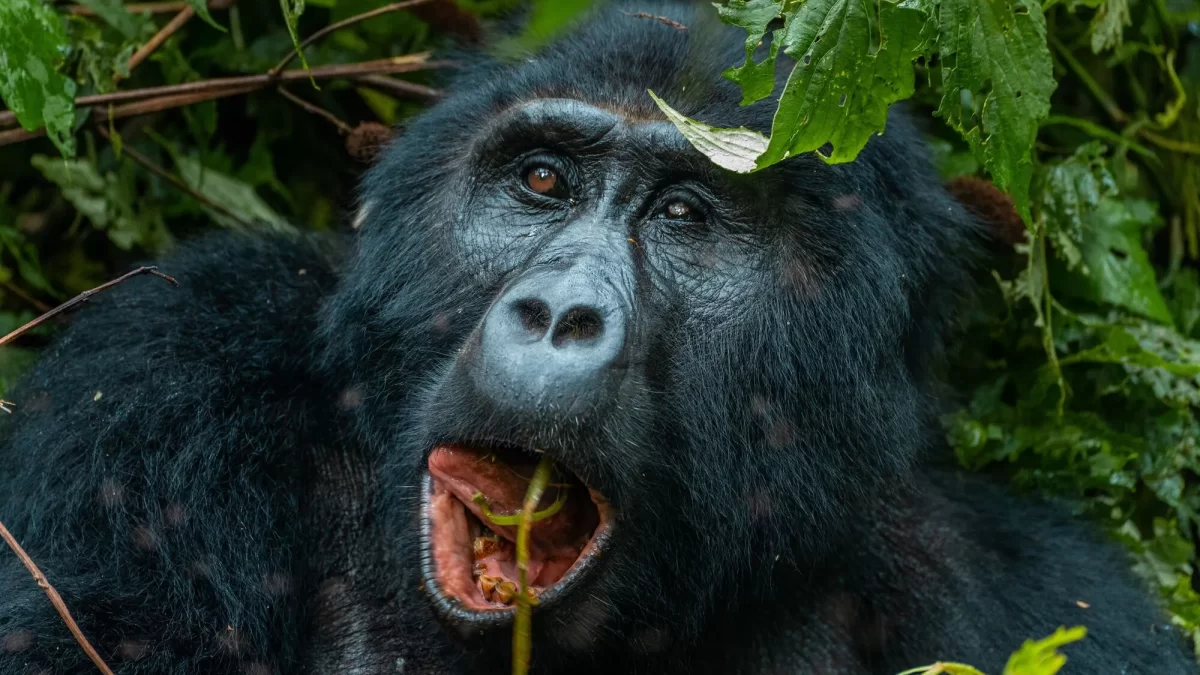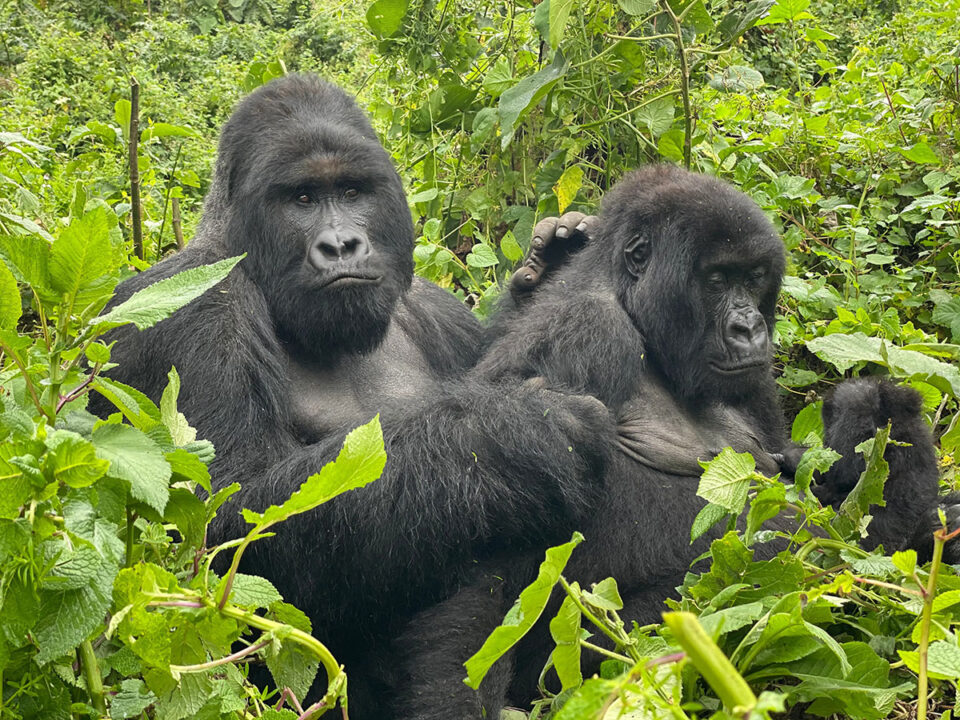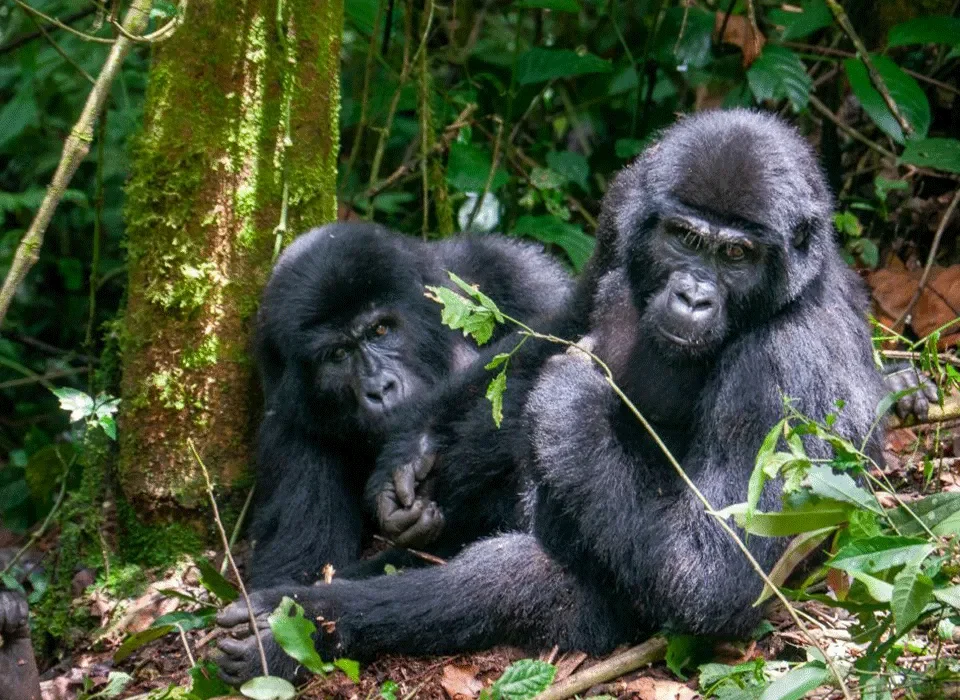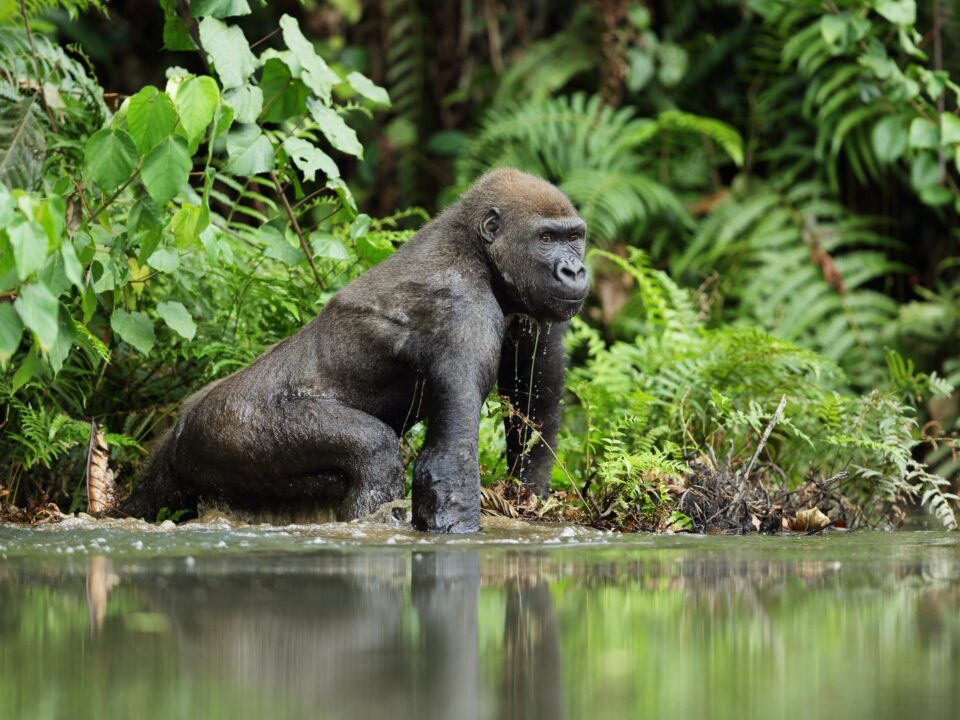Gorilla Trekking Guide for Africa

Nkuringo Region Gorilla Permits and Gorilla Families
February 5, 2024
Budget Uganda Chimpanzee Trekking Safaris
February 6, 2024Gorilla Trekking Guide for Africa with Trek Africa Expeditions
Gorilla Trekking Guide for Africa — Unlock the secrets of mountain gorilla trekking safaris with Trek Africa Expeditions, where we assure you guaranteed gorilla permits in both Uganda and Rwanda. As we navigate through the enchanting world of these magnificent creatures, let’s delve into the diverse subspecies of gorillas and the crucial information you need for an awe-inspiring gorilla trekking adventure.
The Mountain Gorillas: Surviving the High Altitudes
As the name suggests, mountain gorillas inhabit the high mountain forests, dwelling at elevations ranging from 8,000 to 13,000 feet. Adapted to survive in this challenging habitat, they boast thicker and more abundant fur compared to other great apes. This fur is a crucial asset, providing insulation in temperatures that frequently plummet below freezing. However, human encroachment into their territory has pushed these gorillas further up the mountains, exposing them to perilous conditions.
Despite the threats of civil conflict, poaching, and expanding human settlements, both populations of mountain gorillas have experienced a notable increase in numbers. This positive trend is a testament to ongoing conservation efforts, even in the face of adversity.
Eastern Lowland Gorillas: Giants of the Rainforest
The eastern lowland gorilla, also known as Grauer’s gorilla, stands as the largest among the four gorilla subspecies. Distinguished by its stocky build, large hands, and short muzzle, this subspecies predominantly sustains itself on fruit and herbaceous materials. Unfortunately, civil unrest in the Democratic Republic of Congo (DRC) has taken a toll on both the eastern lowland gorilla and the mountain gorilla. Despite challenges, conservation initiatives, including efforts by WWF, aim to protect and preserve these majestic creatures.
Western Lowland Gorillas: Ubiquitous Yet Vulnerable
The western lowland gorilla, the most numerous among gorilla subspecies, spans populations in Cameroon, the Central African Republic, the Democratic Republic of Congo, Equatorial Guinea, Gabon, and the Republic of Congo. Despite their widespread distribution, the western lowland gorilla faces a decline exceeding 60% due to poaching and disease. Conservation measures are imperative to secure the future of this subspecies.
Cross River Gorillas: Navigating a Fragile Existence
Similar in appearance to the western lowland gorilla, the Cross River gorilla faces threats from habitat loss due to human encroachment. Efforts to protect these gorillas focus on securing their forest habitats, with initiatives by WWF and partners establishing protected areas in Cameroon and Nigeria.
Essential Tips for Your Gorilla Trekking Journey
Before embarking on a gorilla trekking trip in Africa, consider these essential tips:
- Ensure physical fitness, as mountain gorillas often inhabit hilly terrains in Africa’s tropical rainforests.
- Purchase travel insurance before undertaking the gorilla trekking safari.
- Pack a portable medical kit for potential issues like stomach upset or injuries during jungle hikes.
- Carry duffel bags for domestic flights with weight restrictions and limited luggage room in safari jeeps.
- Bring cash for tips, souvenirs, and local products, as some places may not accept credit cards.
- Equip yourself with a portable power charger due to inconsistent electricity in Africa.
- Include backpacks, energy bars, a torch, extra camera batteries, quick-dry clothes, and binoculars in your packing list.
Top Gorilla Trekking Destinations in Africa
Explore the best gorilla trekking destinations in Africa:
Rwanda: Volcanoes Gorilla National Park
Located in northwestern Rwanda, this park covers 160 km² and is renowned for its iconic mountain gorillas, with an estimated population of over 400 individuals.
Uganda: Bwindi Impenetrable National Park and Mgahinga Gorilla National Park
Bwindi, in southwestern Uganda, spans 331 km² and hosts an estimated population of 600 mountain gorillas. Mgahinga, in the southern part of the country, covers 33.9 km² and is home to over 20 individuals.
Democratic Republic of Congo: Virunga National Park and Kahuzi-Biega Gorilla National Park
Virunga, in eastern DRC, spans 7769 km² and houses over 200 mountain gorillas. Kahuzi-Biega, near Bukavu, covers 6000 km² and is famous for eastern lowland gorillas, with an estimated population of over 1000 gorillas.
Gabon: Lope Gorilla National Park
Situated in central Gabon, this park covers 4910 km² and is renowned for western lowland gorillas, with an estimated population of over 100.
Central African Republic: Dzanga-Ndoki Gorilla National Park
Located in southwestern CAR, this park covers 1143 km² and is famous for western lowland gorillas, with an estimated population of 2000 gorillas.
Cameroon-Nigeria: Cross River Gorilla Region
This region, with an estimated area of 12,000 km², is the habitat of the world’s rarest gorilla species, the Cross River gorilla, with fewer than 250 mature individuals.
Gorilla Trekking Permits in Africa
It’s crucial to note that all gorilla national parks in Africa are government-owned, and no individual company can possess gorilla permits. Travel agents arrange permits on your behalf.
Best Time for Gorilla Trekking in Africa
The ideal months for gorilla trekking are January, February, June, July, August, September, and December. These months experience less rainfall, making them suitable for gorilla tracking, although demand for permits is high.
What to Pack for Gorilla Trekking in Africa
Prepare for your gorilla trekking adventure by packing essential gear:
- Hiking boots for the challenging terrain.
- Garden gloves for protection during the trek.
- Rain jacket or poncho for unpredictable weather.
- Long-sleeved shirts/blouse to protect against insects.
- Energy-giving snacks for sustenance during the trek.
- Cameras and extra batteries for capturing memories.
- Hat and sunglasses for sun protection.
- Binoculars for enhanced wildlife viewing.
- Portable water bottles to stay hydrated.
Important Rules for Gorilla Trekking in Africa
While gorilla trekking, adhere to these rules to ensure a respectful and safe encounter:
- Minimum age for gorilla trekking is 15 years.
- Limit observation and photography to one hour.
- Maintain a 5-meter distance from mountain gorillas.
- Avoid direct eye contact to avoid upsetting the gorillas.
- Give way to gorillas and avoid overtaking.
- Stay calm if gorillas approach; running increases the risk of harm.
- No flash photography is allowed during gorilla tracking.
- Observe a one-hour limit, with the visit ending early if gorillas become agitated.
- Keep voices down to a minimum while near gorillas.
- Maintain close proximity to your group during gorilla trekking.
- Refrain from tracking gorillas when sick; alternative arrangements can be made.
- Cough or sneeze away from gorillas to minimize the spread of bacteria or viruses.
- Avoid touching or getting too close to gorillas, respecting the 5-meter distance.
- Refrain from smoking, drinking, or eating during gorilla tracking to minimize disturbance.
- Carry back any rubbish brought into the forest.
How to Pay for Your Gorilla Trekking Safari in Africa
Payment methods for gorilla trekking safaris include:
- Bank transfer, which may take 3-30 days, depending on countries’ security situations.
- Credit card payment with a surcharge, using a secure payment link provided by the agency.
- Cash, with a 50% upfront payment and the balance paid in cash upon arrival, with a receipt issued.
Visa Requirements for Your Gorilla Trekking Holiday in Africa
Travelers must possess a valid passport or travel document, valid for at least 30 days after the intended visit. Visa requirements vary by country, so check in advance.
Vaccinations for Your Gorilla Trekking Tour in Africa
Mandatory vaccinations include yellow fever, with additional precautionary vaccinations for diseases like measles, mumps, rabies, rubella, polio, tetanus, diphtheria, whooping cough, hepatitis A and B, and typhoid.
How to Access Gorilla Trekking Destinations in Africa
Access gorilla trekking destinations by air, with domestic flights from main international airports to nearby airstrips. Alternatively, use road transport, with a 4-wheel Toyota Land Cruiser or jeep recommended due to the nature of African roads.
How Safe is Gorilla Trekking in Africa?
Gorilla trekking activities are conducted by trained guides and armed personnel, ensuring safety during the trek. Safety measures are in place to protect visitors from potential dangers.
Age Limit for Gorilla Trekking in Africa
The minimum age for gorilla trekking is 15 years, with no maximum age limit. However, individuals with critical health conditions are not allowed to participate.
How to Book Your Gorilla Trekking Safari to Africa
Book your gorilla trekking safari through:
- Your home travel agency for convenience, albeit at a higher cost.
- Direct contact with a local tour agency, recommended by a fellow traveler or through online research.
- Personal arrangement, contacting gorilla national parks directly, though not advisable due to potential communication challenges or fraud.
What to Expect During Gorilla Trekking in Africa
Anticipate various experiences during gorilla trekking, including:
- Rain, as African weather conditions are unpredictable, making rain jackets essential.
- Potential encounters with other wildlife, such as elephants and buffalos, requiring vigilance from armed rangers.
- Slippery terrains during the rainy season, manageable with proper hiking boots.
- Unexpected gorilla movements due to dominant silverbacks’ fights, requiring longer treks.
- Long drives to reach gorilla families’ locations, avoiding extremely lengthy hikes.
- Higher altitudes in some gorilla families’ habitats, advising asthmatic clients to take precautions.
- Options for private or group gorilla treks, depending on the number of permits purchased.
- Possibility of being carried to and from gorillas using sedan chairs for senior or physically incapable travelers, with an additional fee.
Gorilla Trekking Guide for Africa — Embark on this extraordinary gorilla trekking expedition with Trek Africa Expeditions, where every moment promises a connection with the captivating world of mountain gorillas. Your adventure awaits, promising a blend of awe-inspiring encounters, conservation awareness, and unforgettable memories.




